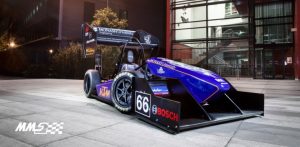Budding F1 car designers & engineers here in Australia may be getting excited in the build-up to the first race of the F1 season with the Australian F1 Grand Prix being held in Melbourne next week (March 14-17), but many of them might also have another important car race in the back of their minds: the 2013 Formula SAE (FSAE) competition, which is the world’s largest student engineering design competition. Starting in 1979 but really gaining in popularity here during the past 15 years, Formula SAE invites highly-motivated engineering students from leading universities around the world to design, manufacture, test and race their own single-seat racecar. Each car is judged for dynamic performance including acceleration, autocross, endurance, fuel economy as well as other important engineering and business-related metrics such as cost, marketing and design philosophy.
We've previously covered the impact of CFD technology on Formula 1 racecar design, but it is clear that CFD technology provides just as much benefit to the leading Formula SAE teams. In Australia, LEAP is proud to be closely associated with many of the local Formula SAE teams, including Monash Motorsport and Team Swinburne FSAE. In particular we'd like to recognise the passion and success of the Monash Motorsport team, who together with Team Leader Scott Wordley have won the past 4 Australasian FSAE titles, and are now ranked 2nd globally (out of 510 graded university teams)!
 CFD has formed a pivotal contribution to the design and testing of the aerodynamic package designed for the most recent Monash FSAE car (shown left, image courtesy Monash Motorsport & Mitchell Stafford), which incorporates imposing front and rear wings and a clever floor diffuser. In any racecar design, competing design goals set the scene for a constant battle to provide maximum downforce for superior braking and cornering performance, without sacrificing raw speed due to increased aerodynamic drag. Inspired by Formula 1 and refined using CFD, one of the 2013 car's secret weapons is a drag-reduction system (DRS) that automatically changes the angle of attack of the main wings at a certain speed to reduce drag when the car approaches top speed down the straight.
CFD has formed a pivotal contribution to the design and testing of the aerodynamic package designed for the most recent Monash FSAE car (shown left, image courtesy Monash Motorsport & Mitchell Stafford), which incorporates imposing front and rear wings and a clever floor diffuser. In any racecar design, competing design goals set the scene for a constant battle to provide maximum downforce for superior braking and cornering performance, without sacrificing raw speed due to increased aerodynamic drag. Inspired by Formula 1 and refined using CFD, one of the 2013 car's secret weapons is a drag-reduction system (DRS) that automatically changes the angle of attack of the main wings at a certain speed to reduce drag when the car approaches top speed down the straight.
Despite its competitive nature, our observation at LEAP is that Formula SAE is also a remarkably close-knit community as evidenced when Monash Motorsport have generously hosted other teams in their workshop and also given other teams access to their world-leading wind tunnel facilities. In conjunction with Monash Motorsport, LEAP Australia is preparing to host a special workshop in April covering the use of ANSYS CFD and FEA software for Formula SAE car design. The 3-day workshop "DESIGN TO WIN" will be held April 2nd-4th at Monash Clayton campus and students from all Formula SAE teams around Australia and New Zealand are invited to participate. Lectures and workshops during this free event will also be specially tailored towards common FSAE design and engineering issues.
We will be sending out invitations to students and teams that are already on our mailing list, but if you'd like to participate please leave a comment below and we will be in touch!






